The fungus of the toenails or onychomycosis is a common problem that every person risks faces life, regardless of age or social status.This disease is accompanied by extremely unpleasant symptoms associated with aesthetic changes in the nails and physiological discomfort.This is due to the fact that the lower limbs are much more in contact with the contaminated environment.In this case, the main cause of the occurrence is reduced immunity.The weakened organism is not able to completely withstand an infectious agent.This is especially true for bathrooms, saunas and pools, showers in fitness rooms or in production, hospital departments.In the first two cases, the risk of infection is high due to visiting such places by people who carry a fungal infection.In addition, mushrooms are multiplied more actively in a humid environment.Hospitals, despite compliance with sanitary standards, are a place of concentration of various infections, including fungal.After becoming barefoot on the floor of one of these places, the likelihood of an infection grows ten times.Even if none of the domestic was ill with onychomycosis, conditionally pathogenic mushrooms that live on human skin, multiply in the unclean bath.Increasing their population leads to deplorable consequences.Microorganisms accumulate in layers of tissue, which also increases the risk of infection.
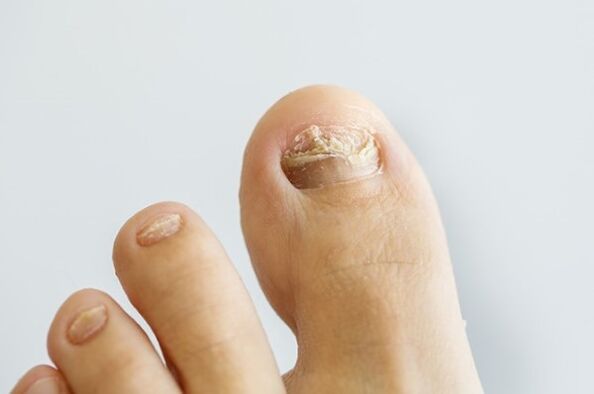
Причини за гъбични увреждания на ноктите
Увреждането на гъбичките на краката по краката в медицинската практика е много по -често срещано от подобно заболяване на ръцете. Това се дължи на факта, че долните крайници са много по -често в контакт със замърсената среда. В този случай основната причина за появата е намален имунитет. Отслабеният организъм не е в състояние напълно да издържи на инфекциозен агент.
Ако говорим конкретно за гъбата върху ноктите на краката, има редица фактори, които допринасят за инфекцията:
- Посещение на обществени места без обувки. Това важи особено за бани, сауни и басейни, душове във фитнес зали или в производството, болнични отдели в болница. В първите два случая рискът от инфекция е висок поради посещаването на такива места от хора, които са носители на гъбична инфекция. В допълнение, гъбите се умножават по -активно във влажна среда. Болниците, въпреки спазването на санитарните стандарти, са място на концентрация на различни инфекции, включително гъбични. След като стане бос на пода на едно от тези места, вероятността да се получи инфекция расте десет пъти.
- При липса на редовно почистване с помощта на агресивна химия, собствената му баня също се превръща в разсад на гъбична инфекция. Дори ако никой от домашните не е бил болен от онихомикоза, условно патогенни гъби, които живеят върху човешката кожа, се размножават в нечистата баня. Увеличаването на населението им води до плачевни последици.
- Носенето на стари или други обувки на хората--условно патогенните гъби са на кожата, техните влизащи обувки (особено затворен тип) са неизбежни. Микроорганизмите се натрупват в слоеве от тъкан, което също увеличава риска от инфекция.
- Wearing shoes is not forged - one of the infection factors is excessive sweating of the feet.If a person walks in closed shoes in the summer or wears warm shoes in the room, the likelihood of damage to the fungus increases.However, periodic nail cutting and casual feet with soap may not be enough.It is important to cut your nails regularly, cut the storms and press the cuticles, use special lotions and constantly clean the keratinized layers of the skin.In such cases, blood circulation is impaired in the damaged area, the nail does not receive the right amount of nutrients.This can provoke the development of fungus.This is due to the possibility of choosing medicines that show activity in connection with a particular type of pathogen and the use of the most effective treatment.
- Dermatophytes
- the most common type of pathogen.According to statistics, dermatophytes cause a fungus on the nails of about 75-80% of cases.In this case, the condition of the immune system plays the main role in the onset of onychomycosis.In normal immunity, fungal damage to dermatophytes is almost impossible.
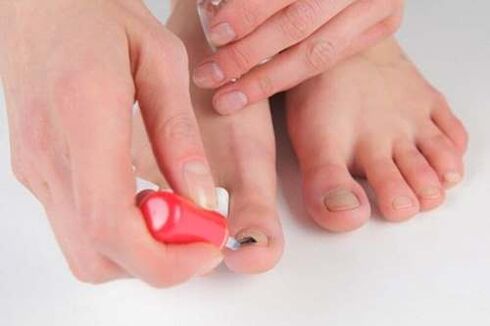
Видове гъби и характеристики на увреждане на ноктите по краката
Характеристиките на лечението зависят от идентифицирането на видовете гъби, които засягат ноктите. Това се дължи на възможността за избор на лекарства, които показват активност във връзка с определен тип патоген и прилагането на най -ефективното лечение.
Дерматофити
Най -често срещаният тип патоген. Според статистиката дерматофитите причиняват гъбичка върху ноктите от около 75-80% от случаите. В този случай състоянието на имунната система заема основната роля при появата на онихомикоза. При нормалния имунитет гъбичните увреждания на дерматофитите са почти невъзможни.
The infection comes from humans or animals that are carriers as well as in contact with soil.Keratinocytes, the cellular structures of the epidermis, the high content of which is observed in the nails are a favorite environment of nutrition of this type of mushrooms.moves to the root of the nails.In most cases, it is this subspecies that affects the toes.It is characterized by simultaneous damage to the nails on several fingers (often standing nearby).The characteristic signs of infection are the thickening of the affected area of the nail and its stratification.The skin under the outside of the nails dries and crusts.
Trichophyton is intergrad - in this case, onychomycosis of the white surface develops.The favorite habitat of subspecies is wet, often found in baths, baths, swimming pools.The causative agent more often affects the thumbs of the lower limbs, after which it "captures" other nails.A characteristic feature is considered to be focal damage to the nail plate with the appearance of individual white spots or strips.In the future, the whitish areas grow, merging together.When the fungal life forms spread to other fingers, there are areas of dried and peeling skin between the toes.They are considered conventional and pathogenic due to the fact that they constantly live on the surface of human skin.That is, for infection, contact with an infected person, animal or external environment does not need at all.In this case, the main trigger of the pathology is a significant reduction in immunity, immunodeficiency.
- Червен трихофит (Rubrum) - Началото на патологичния процес протича на края (външна или свободна) част от нокътя, откъдето инфекцията постепенно се премества в корена на ноктите. В повечето случаи именно този подвидове засяга пръстите на краката. Той се характеризира с едновременно увреждане на ноктите на няколко пръста (често стои наблизо). Характерните признаци на инфекция са сгъстяването на засегнатата област на нокътя и неговото разслояване. Кожата под външната страна на ноктите изсъхва и кори.
- Trichophyton е междуградирана - в този случай се развива онихомикоза на бялата повърхност. Любимото местообитание на подвида е мокро, често се среща във вани, бани, басейни. Причинителният агент по -често влияе на палците на долните крайници, след което „улавя“ други нокти. Характерна характеристика се счита за фокусно увреждане на нокътната плоча с появата на отделни бели петна или ленти. В бъдеще белезникавите райони растат, сливайки се заедно. Когато гъбичните форми на живот се разпространяват в други пръсти, се намират области на изсушена и пилинг кожа между пръстите.
Мая

Друг патоген с гъбични увреждания на краката по краката е условно патогенни гъби от семейство Candida. Те се считат за конвенционално и патогенни поради факта, че те постоянно живеят на повърхността на човешката кожа. Тоест, за инфекция, контактът със заразено лице, животно или външна среда изобщо не се нуждае. В този случай основният спусък на патологията е значително намаляване на имунитета, имунодефицитността.
Unlike dermatophytes, yeast mushrooms do not form a layer of mycelium, that is, the destruction of the nails with this form of damage becomes much less.But the same factor makes the infectious lesion more severe, since the beginning of the pathological process acquires the root (proximal) side of the nail.Such varieties of mycosis are considered to be more severe, but at the same time rare.Therefore, the nail loses its luster, it becomes boring and rough.Damage to nail with yeast mushrooms occurs in about 7-10% of cases.Damage to the fungus of the nail on the legs can cause about 35-40 subspecies of shapes.
Despite spreading to the environment, this form of onychomycosis is rarely diagnosed.In part, as well as because of an atypical clinical picture, mold is more difficult to diagnose and treat.Another reason for the complexity of the diagnosis of mold onychomycosis is the ability of mushroom mushrooms to form mycelium, which makes the clinical picture equalized with damage to the dermatophytes.In the initial stages, the fungus may go unnoticed at all.But there are still symptoms of the early stages of pathology development that are important to pay attention to:
Най -коварният тип гъби, тъй като тези форми на живот се срещат почти навсякъде (но особено във влажна среда). Увреждането на гъбичките на нокътя върху крака може да причини около 35-40 подвид на форми.
Въпреки разпространението в околната среда, тази форма на онихомикоза рядко се диагностицира. Отчасти, следователно, както и поради нетипична клинична картина, плесенът е по -труден за диагностициране и лечение. Друга причина за сложността на диагностицирането на мухъл онихомикоза е способността на гъби от плесен да образуват мицел, което прави клиничната картина да се изравнява с увреждане на дерматофитите.
Формите на гъбичния живот засягат главно ноктите по краката, а инфекцията с подвида е около 10-15%.
Клинична картина
Повечето видове гъбични увреждания на плаките за ноктите напредват бавно. На началните етапи гъбичката изобщо може да остане незабелязана. Но все пак има симптоми на ранните етапи на развитието на патологията, които са важни да обърнат внимание на:
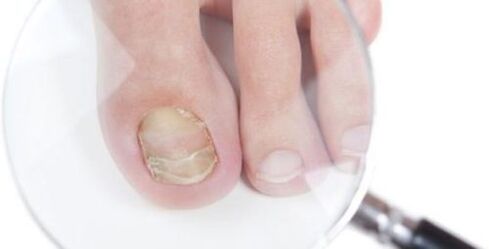
- Growth impairment is the first and most notable sign.In a state of the norm, the nail of the leg grows no more than 2 mm per week.The nails affected by the fungus slow down the speed of growth.It also notes the appearance of white or yellow, cut to the surface of the nail or a complete change in the color of the nail plate (white, yellow or shades of brown).Changing the color from the nail fungus in the photo above.If the storms have begun to appear more frequent and the area of the cuticle becomes inflamed or damaged, it is worth checking for a fungal lesion.
- Thickening or thinning of the nails -variations depend on damage to the specific types of mushrooms.The clinical signs of later stages of onychomycosis include:
- Changing the surface of the nails - it becomes rough and uneven, full of tubercles and waves.Also, the nail may appear with similarities of crumbs, which shows a gradual separation of the upper layer of the nail.
- In even the shorter stages, the nail gradually begins to collapse.Initially, this is expressed in the stratification of the nails, the appearance of cracks on the entire surface or chips on the outer edge.Here's what this characteristic of the sponge on the toenails of the legs of the photo.
In the future, destruction is even more severe.The nail literally breaks down without time growing.At the same time, the subordinate sections of the dermis are exposed, and the rest of the nails look clearly painful and unattractive.As a result, there is a risk of complete destruction or detachment of the nails.Heavy lesion with a nail fungus in the photo above.
- В дори по -късните етапи нокътя постепенно започва да се срива. Първоначално това се изразява при стратификацията на ноктите, появата на пукнатини на цялата повърхност или чипс на външния ръб. Ето как изглежда тази характеристика на гъбата върху ноктите на краката на снимката.
- В бъдеще унищожението е още по -тежко. Нокът буквално се разпада, без време да расте. В същото време са изложени подчинените участъци на дермата, а останалите части на ноктите изглеждат ясно болезнени и непривлекателни. В резултат на това съществува риск от пълно унищожаване или откъсване на ноктите. Тежка лезия с гъбичка на нокътя на снимката по -горе.
The danger of complications
Very unpleasant sensations and worsening of the onenose of the feet are only the upper iceberg.The lack of timely treatment threatens the development of complications, among which are considered the most common:
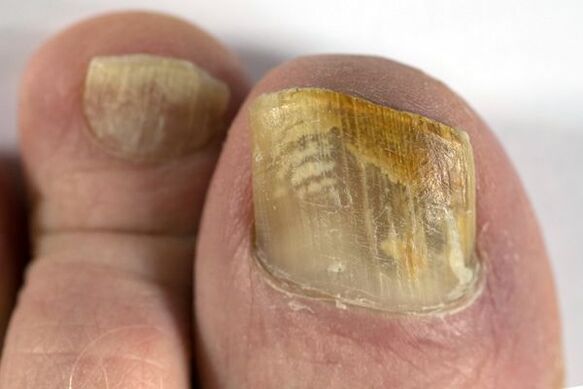
- Allergic reactions - at certain stages of development, the fungus of the legs can be perceived by the body as an allergen.the affected areas.As a result, inflammatory and purulent processes develop.In this case, the fungal life forms can penetrate the bloodstream and will be located throughout the body.At the same time, it is important to perform diagnostics by sowing a bacterial environment to determine the type of pathogen and to choose the most effective drugs.The integrated approach involves the combination of several types of therapy, but sometimes this is not enough.As part of the treatment, two main drug groups are used, depending on the stage of development of the pathological process:
- Липсата на лечение на онихомикоза позволява да се присъединят към други инфекции в засегнатите райони. В резултат на това се развиват възпалителни и гнойни процеси.
- Особено тежки случаи, подложени на продължителен курс и прогресиране на заболяването, могат да доведат до развитието на гъбична микоза. В този случай гъбичните форми на живот могат да проникнат в кръвта и ще бъдат разположени в цялото тяло.
Методи за лечение
За максимална ефективност на лечението на гъбичките на ноктите върху краката често се използва сложна терапия. В същото време е важно да се провежда диагностика чрез сеитба на бактериална среда, за да се определи вида на патогена и да се избере най -ефективните лекарства. Интегрираният подход включва комбинацията от няколко вида терапия, но понякога това не е достатъчно.
Лекарства
Лекарствената терапия е основа за лечението на повечето патологии, включително гъбични лезии на ноктите. Като част от лечението се използват две основни групи лекарства, в зависимост от етапа на развитие на патологичния процес:
- Local type of action - they include ointments, gels, varnishes, creams, sprays and lotions with antifungal activity.The method, multiplicity and duration of use of such drugs are determined by a doctor, but in most cases they are used for at least 2-3 weeks.In the bigger part, these are tablets that, after suction from the gastrointestinal tract, penetrate the bloodstream and inhibit the forms of fungal life, and also do not allow mycosis to spread.The use of systems is important not only to improve the therapeutic effect, but also to prevent recurrence.Folk recipes can enhance the antifungal effect.The most effective of these are considered:
- iodine - is able to dissolve the protein structures that underlie fungal life forms.For daily treatment, apply a few drops of iodine to the affected areas with cotton pad.
Peroxide is an effective antibacterial agent that has a disinfectant.To improve the effect, peroxide is mixed in equal proportions with vinegar.Then the patient is lubricated with a mixture, you do not need to rinse it.The procedure is repeated daily for 1-2 weeks.To do this, take a tablespoon of crushed raw materials (leaves and twigs), pour 0.5 liters of water and bring to a boil.The decoction is protected within 15-20 minutes, after which the legs are dipped in it for another 20-25 minutes.Repeat the procedure every day before going to bed for 2-3 weeks.
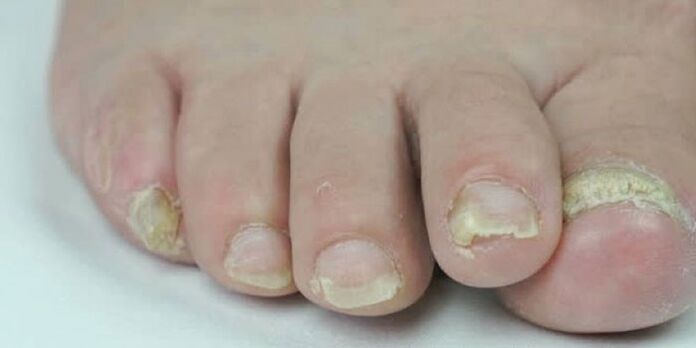
Традиционната медицина се счита за спомагателен метод за борба с гъбичките на краката. Народните рецепти могат да засилят противогъбичния ефект. Най -ефективните от тях се считат:
- Йод - е в състояние да разтвори протеиновите структури, които са в основата на гъбичните форми на живот. За ежедневно лечение нанесете няколко капки йод върху засегнатите участъци с памучна подложка.
- Пероксидът е ефективен антибактериален агент, който има дезинфектант. За да се подобри ефекта, пероксидът се смесва в равни пропорции с оцет. Тогава пациентът се смазва със смес, не е необходимо да го изплаквате. Процедурата се повтаря ежедневно в продължение на 1-2 седмици.
- Celandine - Най -добрият метод за използване на това растение за лечение на гъбички върху ноктите на краката е Poultices. За да направите това, вземете супена лъжица натрошени суровини (листа и клонки), изсипете 0,5 литра вода и доведете до кипене. Отварата се защитава в рамките на 15-20 минути, след което краката се потопят в нея за още 20-25 минути. Повторете процедурата всеки ден преди лягане за 2-3 седмици.
Removal of the nail
Today, the chemical method for nail removal - avulces is mainly used in medical practice.For this, special aggressive medicines are used, the procedure is performed by a doctor to prevent damage to healthy areas of the nails and skin.This method is painless and effective, and the indications for its use are the lack of conservative treatment results or advanced cases of onychomycosis.
Laser therapy
The procedure involves partial or complete removal of the nails.The choice of the method depends on how deep the fungus penetrates the nail structure.In the course of laser therapy, an intensive laser irradiation method is used.Special apparatus is removed with fungal layers of the nail, followed by a course for antifungal therapy.In this case, after removal, a dressing is applied to the bare areas of the skin under which a ointment or cream with antifungal effect can be applied.Removing nails requires regular visits to the doctor to perform dressings and to observe the growth of the new nails.If the removal is shown, the procedure goes away and takes about 20 minutes, the patient does not experience pain.

Лазерното обработка на гъбичките на ноктите по краката, по време на които се отстраняват само няколко слоя от нокътя, се извършва на етапи, в рамките на 7-10 процедури (за обработка на всеки пирон са необходими около 10-15 минути). Ако е показано отстраняването, процедурата отминава и отнема около 20 минути, пациентът не изпитва болка.

















